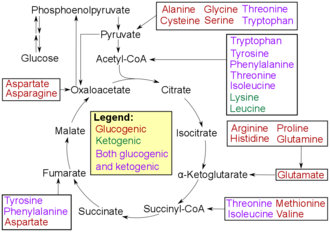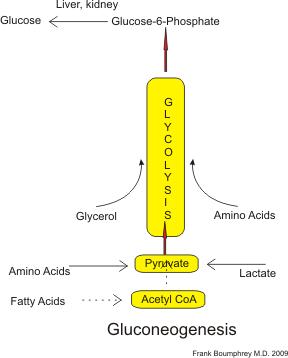Gluconeogenesis
Gluconeogenesis (GNG) is a chemical process in living bodies. In gluconeogenesis, the body turns fats and proteins (glucogenic amino acids) into sugars called glucose.[1] In most animals with spines, gluconeogenesis happens in the liver, but some animals have gluconeogenesis in the kidneys.[2] gluconeogenesis usually happens when the organism has not eaten many starches or sugars or eaten nothing at all for a long time. Not eating and not eating starch can cause ketosis, which is when some cells cannot use ketones for fuel.[3]
Process

- Glucogenic amino acids have this ability
- Ketogenic amino acids do not. These products may still be used for ketogenesis or lipid synthesis.
- Some amino acids are catabolized into both glucogenic and ketogenic products.
In humans, the main gluconeogenic compounds are lactate, glycerol (a part of the triglyceride molecule), alanine and glutamine. They are mostly involved in over 90% of the overall process.[5]
Lactate comes back to the liver where it is converted into pyruvate by the Cori cycle using the enzyme lactate dehydrogenase. Pyruvate, the first designated substrate of the gluconeogenic pathway, can then be used to make glucose.[6]
Fat is mostly broken down, but if there is no fat to break down, or the body cannot access the fat stores, then proteins found in the muscle can break down, resulting in muscle loss.[7]
Gluconeogenesis Media
Gluconeogenesis pathway with key molecules and enzymes. Many steps are the opposite of those found in the glycolysis.
References
- ↑ Lehninger, Albert L.; Nelson, David L. (David Lee); Cox, Michael M. (2000). Lehninger principles of biochemistry. Duke University Libraries. New York : Worth Publishers. ISBN 978-1-57259-153-0.
- ↑ "Key protein causing excess liver production of glucose in diabetes identified". ScienceDaily. Retrieved 2021-06-03.
- ↑ Lua error in Module:Citation/CS1/Identifiers at line 630: attempt to index field 'known_free_doi_registrants_t' (a nil value).
- ↑ Ferrier DR, Champe PC, Harvey RA (1 August 2004). "20. Amino Acid Degradation and Synthesis". Biochemistry (Lippincott's Illustrated Reviews). Hagerstwon, MD: Lippincott Williams & Wilkins. ISBN 978-0-7817-2265-0.
- ↑ Gerich JE, Meyer C, Woerle HJ, Stumvoll M (February 2001). "Renal gluconeogenesis: its importance in human glucose homeostasis". Diabetes Care. 24 (2): 382–91. doi:10.2337/diacare.24.2.382. PMID 11213896.
- ↑ Garrett RH, Grisham CM (2002). Principles of Biochemistry with a Human Focus. USA: Brooks/Cole, Thomson Learning. pp. 578, 585. ISBN 978-0-03-097369-7.
- ↑ Lua error in Module:Citation/CS1/Identifiers at line 630: attempt to index field 'known_free_doi_registrants_t' (a nil value).


